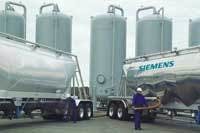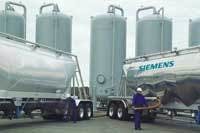by Douglas Gillen and Dr. James Graham
Interest in using reactivated carbons in water purification has increased significantly after the recent decision by the Department of Commerce (DOC) affirming their preliminary tariff on virgin steam-activated carbons. This decision, recorded in the Federal Register on March 2, 2007, imposes anti-dumping duties on activated carbons imported from China. Import tariffs have been set between 70% and 228% depending on an exporter’s status in responding to the DOC.
These tariffs, a result of the anti-dumping petition brought at the start of 2006 by Norit Americas and Calgon Carbon Corp., have immediately and significantly increased the cost of virgin granular and powdered activated carbons imported into the United Sates from China. The tariff has also driven price increases in the broader market for virgin activated carbon such as coconut shell-based carbons from non-subject countries and domestically produced coal-based activated carbons.
As a result, virgin activated carbon users are more closely looking at alternative treatment technologies such as air stripping, advanced oxidation, thermal oxidation, etc., or where an alternative technology isn’t practical, they are simply accepting this near doubling of the price for carbon.
These increased costs for virgin carbons have renewed interest in a “green” solution: the replacement of virgin activated carbons with reactivated carbons. This material can be used in both potable and non-potable water treatment as well as in vapor phase applications.
Reactivated Carbon Production
Reactivated carbons are produced by processing spent carbons at a specialized facility using steam and elevated temperatures in a process that is nearly identical to that used in the production of virgin activated carbons. Reactivation restores the surface area and pore volume of the spent carbon to the point where its performance is close to that of virgin carbon.
The organic materials driven off the spent carbon during the reactivation process are completely mineralized in the reactivation furnace and by oxidation in the afterburner to form simple environmentally acceptable compounds. Additionally, since the reactivation process ends the chain of custody for the adsorbed contaminants, a Certificate of Reactivation (COR) is often provided to clients to certify that the carbon has been recycled in a manner that meets or exceeds all applicable RCRA and benzene NESHAP regulations.
This process can be applied to activated carbons used in both liquid phase and vapor phase applications. Also, both coal- and coconut-based carbons can be used in the reactivation programs with equally good results. The coconut shell carbons are physically harder than are the coal-based carbons, and the losses due to attrition during handling and reactivation are significantly less for the coconut shell carbons.
Once the reactivation process has been completed, the reactivated carbons are screened to specific size distributions, and, after undergoing quality control certification, are packaged and made ready for use in either the same or a new application.
The ability of the reactivation process to restore the carbon’s original absorption properties is a function of following:
- The quality of the original virgin carbon material.
- The nature of the organic contaminants that were adsorbed and their ease of removal.
- The reactivation process and type of reactivation furnace used and conditions of operation (residence time, reactivation temperature, steam partial pressure, and reactivation gas composition).
Product Quality
The reactivation process will recover 80% - 95% of the theoretical adsorption capacity available from the previous run. Often, clients will find in actual applications that there is little noticeable difference between the performance of virgin and reactivated carbons. Capacity loss experienced with reactivated carbon varies greatly with the properties of organic contaminants that were being adsorbed. For example, the adsorption of larger, easier-to-adsorb organic molecules such as TPHd, PNAs, PCE, O&G, will be less affected by the reactivation process, as these compounds are less dependent on the presence of micropores for full capacity loading.
Reactivated carbons are evaluated in a manner that is similar to the process used to evaluate virgin carbons, namely through the uses of ASTM and AWWA standard test methods to measure such properties as iodine/ butane number, abrasion/hardness number, particle size distribution (mesh size), apparent density and moisture content. These measures of reactivated carbon quality are used not only to estimate the performance of the carbon when used in an application but to compare against competitive virgin materials.
Metals leaching from both virgin and reactivated carbons should always be evaluated. Activated carbons do not contain a large number of ion exchange sites, and have a relatively low capacity for picking up metals that may be in the water being treated. After repeated use, however, reactivated carbons can accumulate metal contaminants that may be present in the water being treated. These metals typically include aluminum, calcium and magnesium, which are found in hard waters as well as heavier metals such as iron, manganese, and nickel, if they are present. Because these metals are not removed during the reactivation process, their concentrations can build up on the recycled carbon. In most cases, these metals have low water solubilities and show low leachability when the carbon is used again in a water treatment application. For sensitive applications where the introduction of these metals back into the water being treated is not allowed, the level of metal contamination of the reactivated carbon needs to be monitored and the carbon needs to be replaced if levels exceed a certain threshold.
Drinking Water Applications
For potable water applications, the use of a reactivated carbon is often controlled by a state drinking water regulatory agency. They often require that reactivated carbons be applied under a “React and Return Program.” This program mandates that reactivated carbons must be segregated during storage and returned to the same well site for reuse. The owner of this “react and return” carbon only receives the carbon that has been at their site plus any virgin makeup that may be required.
Losses due to attrition (fines generation) and gasification in the reactivation furnace typically average 10% - 25% based on the spent material being processed. These loses are made up by adding virgin carbon to the reactivated carbon before returning the combined medias to the site. This addition of virgin material returns the volume of carbon back to its original value and has the benefit of increasing the iodine number of the recycled product to specified values.
Many examples exist where “react and return” has been used to significantly reduce the cost of using carbon in groundwater cleanup. For example, a Southern California municipality uses reactivated carbons to treat groundwater contaminated with both TCE and perchlorate. They now have a controlled carbon cost for future budgeting. Another municipal site has switched to reactivated coconut carbon using the react and return program for the removal of MTBE in drinking water in order to reduce their operating cost.
Many users of activated carbon that are not involved in the production of drinking water can make use of reactivated carbons for their remediation and process purification needs. These applications include groundwater remediation, refinery wastewater discharge, and metal plating operations, among many others. At these sites, they can make use of reactivated carbon from a general pool of carbon that has been segregated according to adsorption properties and mesh size required for the particular application.
Each application should be evaluated to determine whether reactivated carbon is the appropriate choice for the particular contaminant removal that is required. This evaluation is rapid and often provided at no charge by the suppliers of reactivated carbons.
About the Authors:
James Graham is senior scientist at Siemens Water Technologies. He earned a Ph.D. in inorganic chemistry from Iowa State University and a B.S. in chemistry from Indiana State University. He has over 30 years of research and development experience in the areas of adsorption using activated carbon, homogeneous and heterogeneous catalysis, conversion of coal to chemicals and petroleum hydrodesulfurization. He can be reached at [email protected]. Douglas Gillen is the director of environmental products with Siemens Water Technologies. A chemical engineer with a degree from Tufts University, Gillen has been with Siemens for 10 years and is based in San Francisco. He can be reached at [email protected].




